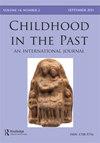当孩子们标志着变化:公元前9世纪至5世纪在Pontecagnano (Salerno, Campania)的丧葬仪式和社会人口动态
IF 0.5
Q3 ANTHROPOLOGY
引用次数: 2
摘要
摘要庞特卡尼亚诺是意大利南部最大的前罗马时代遗址之一,以其墓地而闻名,位于有人居住的地区周围。对墓地的考古发掘已经发现了一万多个墓葬。几项研究强调了公元前9世纪至3世纪定居点发展的不同阶段,这些阶段以重大的社会和文化转变为标志。反过来,这些时期也反映在丧葬习俗的变化上。本研究旨在通过对非成年人群的跨学科分析,为这些社会转型提供进一步的证据。该分析综合了考古、人类学和考古学数据,涉及三个时间和空间上不同的墓葬区的152座墓葬:Colucci(铁器时代早期,公元前9世纪至8世纪);德基亚拉(东方化时期,公元前7世纪-6世纪);巴尔迪(古代,公元前6世纪-公元前5世纪上半叶)。本文章由计算机程序翻译,如有差异,请以英文原文为准。
When Children Mark the Change: Funerary Rituals and Socio-Demographic Dynamics in Pontecagnano (Salerno, Campania) between the 9th and 5th Centuries BCE
ABSTRACT Pontecagnano is one of the largest pre-Roman sites in southern Italy, best known for its necropolises, located around the inhabited area. Archaeological excavations of the burial areas have uncovered more than ten thousand burials. Several studies have highlighted different phases of the settlement’s development from the 9th to the 3rd century BCE, which are marked by major societal and cultural shifts. In turn, these periods are reflected by changes in funerary customs. The present study aims to provide further evidence of these social transitions through an interdisciplinary analysis focused on the non-adult population. The analysis integrates archaeological, anthropological, and archeozoological data relating to 152 burials from three chronologically and spatially distinct funerary sectors: Colucci (early Iron Age, 9th century – 8th century BCE); De Chiara (Orientalizing period, 7th century – 6th century BCE); and Baldi (Archaic period, 6th century – first half of the 5th century BCE).
求助全文
通过发布文献求助,成功后即可免费获取论文全文。
去求助
来源期刊

Childhood in the Past
Social Sciences-Anthropology
CiteScore
0.90
自引率
0.00%
发文量
16
期刊介绍:
Childhood in the Past provides a peer-reviewed, interdisciplinary, international forum for the publication of research into all aspects of children and childhood in the past, which transcends conventional intellectual, disciplinary, geographical and chronological boundaries. The editor welcomes offers of papers from any field of study which can further knowledge and understanding of the nature and experience of childhood in the past.
 求助内容:
求助内容: 应助结果提醒方式:
应助结果提醒方式:


